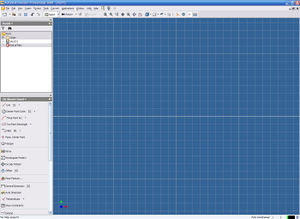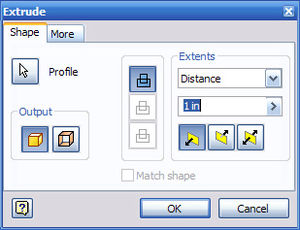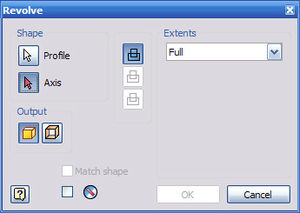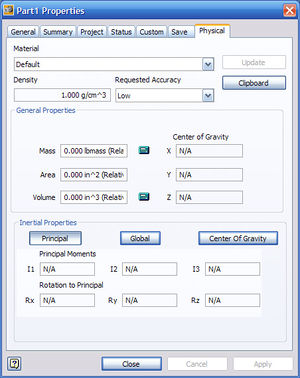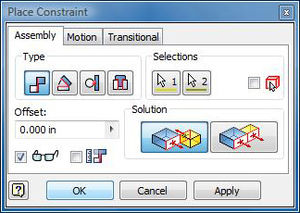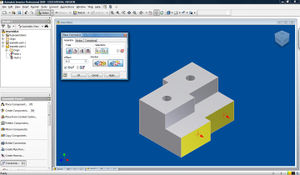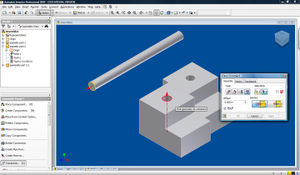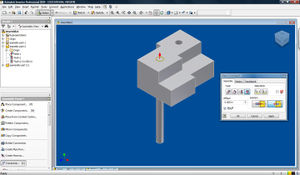Difference between revisions of "How to Guide Inventor"
(→Putting the Parts Together) |
(→Putting the Parts Together) |
||
| Line 92: | Line 92: | ||
## Bumpers | ## Bumpers | ||
| + | [[Image:Inv_assembly_win.jpg|thumb|right|Constraint dialog in Inventor]] | ||
===Constraints=== | ===Constraints=== | ||
| + | |||
| + | Constraints, like in the sketching phase, are used in assembly phase to align parts in the fashion it will resemble in real life. First components must be placed, with the first component as grounded. Then the constraints dialog can be pulled up by hitting the key. | ||
| + | |||
| + | The first tab deals with assembly constraints and it is what we will be working with here. The options here are mate, angle, tangent and insert. They respectively align faces, corners, circular objects and cylinders to other faces, corners, surfaces and holes. | ||
| + | |||
| + | ===Mate=== | ||
| + | [[Image:Inv_assembly_4.jpg|thumb|left|Flush with a .2 in offset]] | ||
| + | [[Image:Inv_assembly_2.jpg|thumb|right|Mate]] | ||
| + | Mate is the first option and it comes in two modes, flush and mate. Two surfaces are selected and then they are stuck next to each other when using mate. | ||
| + | |||
| + | Flush (seen left) on the other aligns surfaces or planes with each other. A typical set of constraints use a single mate and two flushes to firmly stick two components to each other in a rigid orientation (three dimensions of movement requires three constraints). Offsets can also be described for additional flexibility in binding components together. | ||
| + | |||
| + | ===Insert=== | ||
| + | [[Image:Inv_assembly_5.jpg|thumb|left|Axial arrows on circular faces when selecting surfaces for insertion]] | ||
| + | [[Image:Inv_assembly_6.jpg|thumb|right|Axes are aligned in the same direction]] | ||
| + | Insert typically inserts a cylindrical object into a hole. The first two selections of the participating circular faces also show an axial arrow. | ||
| + | |||
| + | There is an option to have the arrows oppose each other or point in the same direction. This gives two different types of inserts, so choose the circular face correctly may save time and additional constraints. | ||
| + | |||
| + | Insert constraints have variable offsets as well, and if no offset is specified, then the components are free to slide along the highlighted axis of insertion. | ||
==Making what you just did Useful== | ==Making what you just did Useful== | ||
Revision as of 15:06, 30 August 2009
Inventor, produced by Autodesk, is the 3d solid modeling software currently used in the FIRST Robotics Competition (this guides target) and by our RoboCup Small Size team. The software can be downloaded for free at http://students.autodesk.com (you need a valid email address from a college ie. your @gatech.edu address). The most recent release is Inventor 2008 (which is what this guide will use).
Contents
Setting Up Inventor
In order to do anything you need to setup your project file. By creating this you can more easily keep track of just project X or project Y and have them on the same machine.
To Do This:
- Go to File
- Projects
- Click the new button
- Fill in the requested info
Note: There are many ways to get to the projects window.
Now you will have you new project listed in the project window. However when you start inventor you will not by default be working in it. To make this the default project just double click on your project in the list. Now when you start you will always be working with it.
Making a Part
First we need to create a part file. To do this File > New > Select Standard.ipt
Making a Sketch
Like AutoCAD (also made by Autodesk) Inventor has many shortcut keys (some of them are the same). To your left you will see two panels. On the top you have Model and on the bottom you have 2D Sketch. The bottom panel will change depending on what you are doing (Note: these are the default locations and these windows are movable). You will also notice beside each title there is a drop down arrow these provide more features which you can explore. Though generally you will not use these additional features.
Generally (by default) the top panel will house info about the current file you are in and the bottom panel will hold commands that you can use to create your product.
Lines
To do a line you can hit L and then click around to draw what you need to. To stop drawing lines (along with any other command) hit Esc. By default lines will attempt to orient them selves parallel and perpendicular with other lines.
Circles
There is more than one way to make a circle. By default and when you hit C it will make one from the center of the point that you select. To change this click the down arrow beside the circle button.
More
You can also create boxes. More importantly there is a trim command short cut X. With trim you could draw a triangle and place a circle on the end of it. Then remove only the lines that you want and end up with an ice cream cone.
Project Geometry is is by far one of the most useful tools (later on once you have more than one file). With this you can bring forward outlines from other parts or features on the same part and create sketches that a driven off of something else. These sketches will automatically update when that something else is changed.
Dimensioning
Before we go any further we need to fully dimension our sketch. This keeps it from changing and locks it in place. As of now all of our lines will be green and once we are done they will be black. To get started hit D. (Note: You can auto dimension the sketch however sometimes it is better to manually do it. You may want your sketch to be based off of direction X or Y and keep this or that side more readily adjustable.) You may need to specify its distance from the origin. To do this make the axises visible and project their geometry.
Once you have created a dimension you can edit it by click on it (it will go from black to red while hovering). You can input any formula you want.
A dimension can also be based of off of other dimensions. To do this simply create a dimension like you would normally and edit it. Once the window is up for you to key in a formula or number click on the dimension(s) you want it to be based off of. You can then manipulate them as if they were variables in an equation (which they are).
Extrusions
In order to make your 2-dimensional sketch into something more tangible you will need to utilize various extrusions depending on your situation. Overtime you will figure out what your situation is and what to do.
Normal
This makes a perpendicular projection of set length from a selected profile (sketch). To do this hit E. A window will appear with options on how to preform the extrusion.
To preform a Normal Extrusion:
- Hit E
- Select profile or sketch
- Key in distance
- Select direction (Forward, Backward, or 1/2 forward & 1/2 backward)
Revolved
Produces a rotation of X degrees around a specified axis. You can added a line to your sketch and use it as that rotation axis or use an edge of the sketch.
To preform an Revolved Extrusion:
- Hit R
- Select the profile or sketch
- Select axis of rotation
- Specify extent (Full = 360, To = To a face, To From = From one location to another location, Angel = Specify degree)
Swept
Holes
It is better to use the hole tool when placing holes instead of drawing them into your sketch initially and extruding or doing a cut. This tool will allow you to edit them with out going back in to the sketch later and there for save you some time. It will also allow to specify the thread, the depth, if its counter sunk and so on.
Properties
Now that you part is complete you are not done! Go to File > iProperties > Physical Tab
Set your material type and hit update. Then apply and close the window. Doing this allows inventor to: a) give you and estimated weight of your robot and b) give you a estimated cg location. Note: If you have a part like fan or an entire assembly like a motor you can weight the thing and then manually key in its mass on that window.
Putting the Parts Together
Now that you have your parts lets put them together to make some sort of subsystem, product, etc. To do this you will need to create an assembly. Note: Assemblies can be composed of parts and other assemblies.
Ideally your robot's assembly structure could look like this:
- Main Robot Assem
- Drive Train Assem
- Gearbox Assem
- Gears (Parts)
- Plates (Parts)
- Shaft (Part)
- Gearbox Assem
- Frame Assem
- Tubes / Angle (parts)
- Bolts (parts)
- Manipulators
- Bumpers
- Drive Train Assem
Constraints
Constraints, like in the sketching phase, are used in assembly phase to align parts in the fashion it will resemble in real life. First components must be placed, with the first component as grounded. Then the constraints dialog can be pulled up by hitting the key.
The first tab deals with assembly constraints and it is what we will be working with here. The options here are mate, angle, tangent and insert. They respectively align faces, corners, circular objects and cylinders to other faces, corners, surfaces and holes.
Mate
Mate is the first option and it comes in two modes, flush and mate. Two surfaces are selected and then they are stuck next to each other when using mate.
Flush (seen left) on the other aligns surfaces or planes with each other. A typical set of constraints use a single mate and two flushes to firmly stick two components to each other in a rigid orientation (three dimensions of movement requires three constraints). Offsets can also be described for additional flexibility in binding components together.
Insert
Insert typically inserts a cylindrical object into a hole. The first two selections of the participating circular faces also show an axial arrow.
There is an option to have the arrows oppose each other or point in the same direction. This gives two different types of inserts, so choose the circular face correctly may save time and additional constraints.
Insert constraints have variable offsets as well, and if no offset is specified, then the components are free to slide along the highlighted axis of insertion.
Making what you just did Useful
Drawing Files
Dimensioning
Appendix
Useful Short Cut Keys
- Inventor Wide
- Zoom to fit = Home
- Look at face = Page Up
- Ending a command = Esc
- Pan = F2 (Hold)
- Zoom = F3 (Hold)
- Rotate = F4 (Hold)
- Cycle Through Views = F5
- Isometric View = F6
- Parts
- 2D Sketches
- Line = L
- Circle = C
- Trim = X
- Dimension = D
- Modeling
- Extrude = E
- Revolve = R
- Fillet = F
- Mirror = Ctrl + Shift + M
- Circular Pattern = Ctrl + Shift + C
- Rectangular Pattern = Ctrl + Shift + R
- Loft = Ctrl + Shift + L
- Sweep = Ctrl + Shift + S
- 2D Sketches
- Assemblies
- Drawings
Mouse Use
- Pan = Center Click
- Zoom in / out = Scroll up / down
